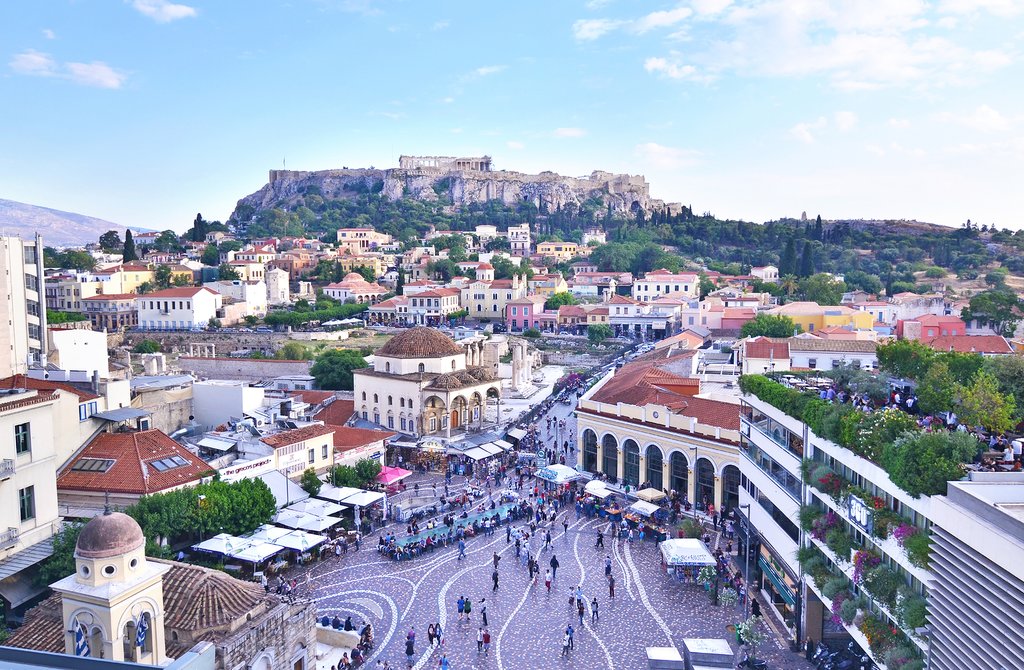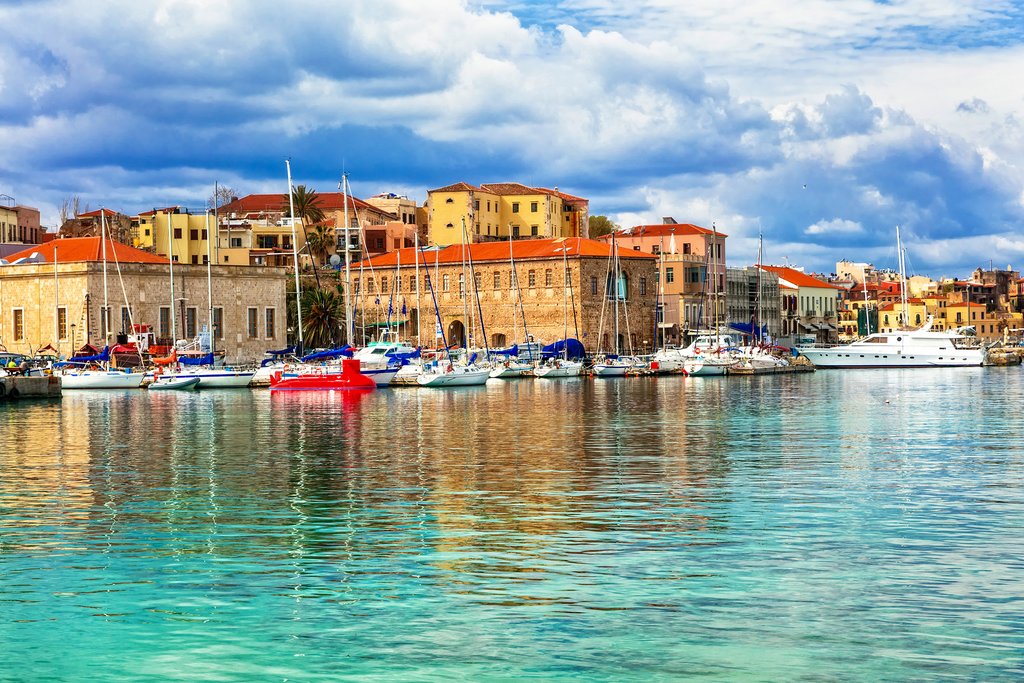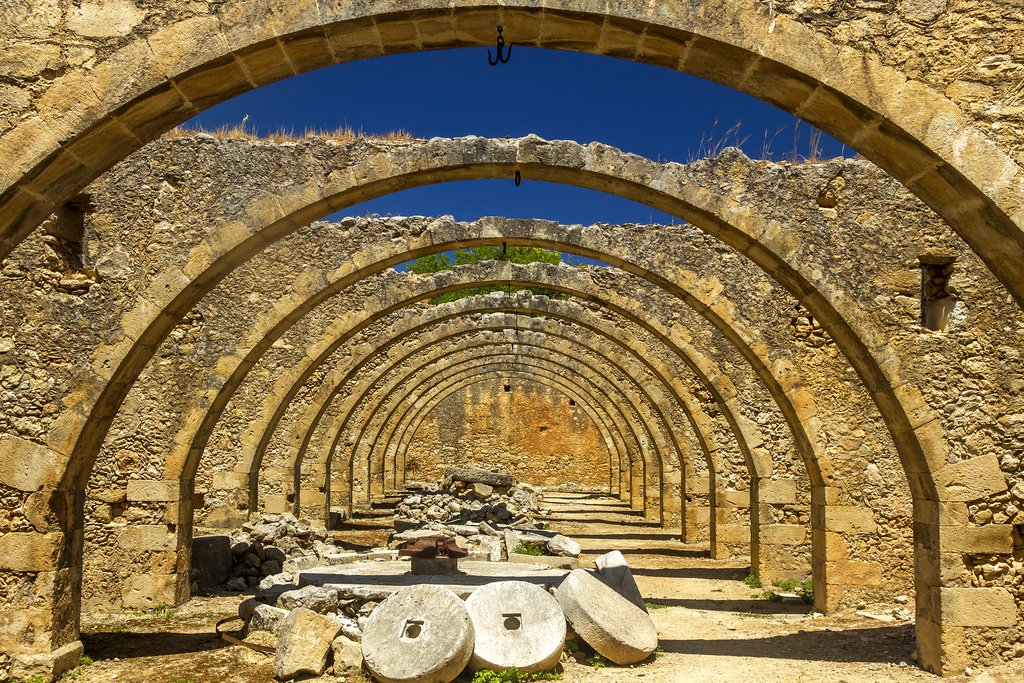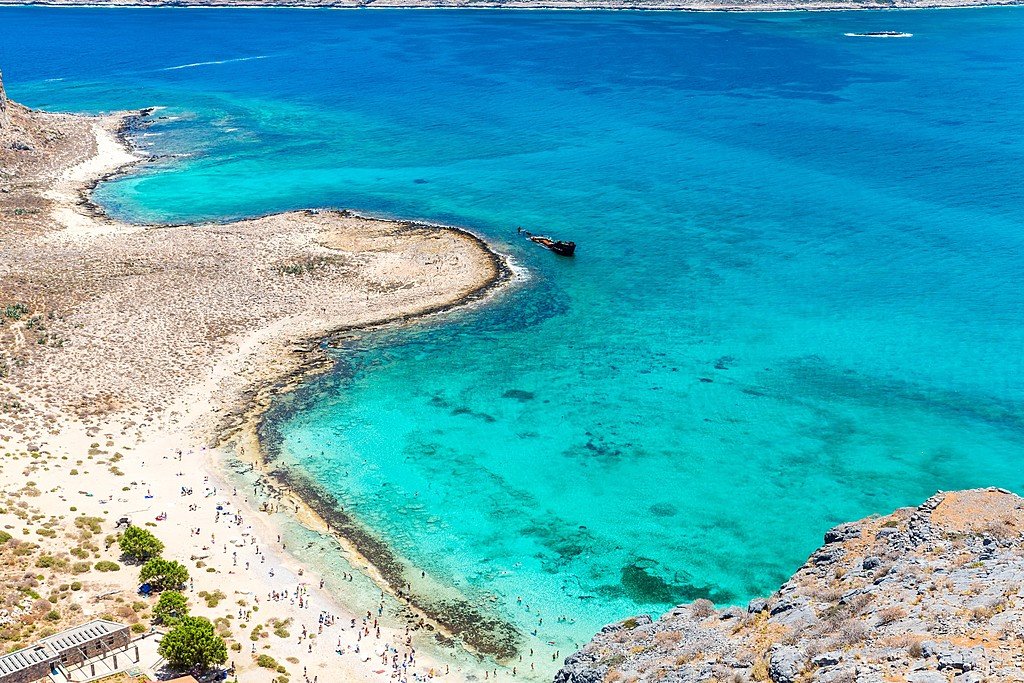Highlights
- Climb to the clifftop monasteries of Meteora
- Consult the oracle at the sacred site of Delphi
- Watch the sun set over the Temple of Poseidon
- Cruise through Santorini's caldera
- Explore villages and beaches on Crete
Brief Itinerary
| Day | Highlights | Overnight |
|---|---|---|
| Day 1 | Arrive in Athens | Athens |
| Day 2 | Ancient & Modern Athens Tour | Athens |
| Day 3 | Travel to Meteora, Monastery Tour | Kalabaka |
| Day 4 | Meteora to Delphi | Delphi |
| Day 5 | Delphi to Olympia | Olympia |
| Day 6 | Olympia to Nafplio | Nafplio |
| Day 7 | Return to Athens, Sunset at Cape Sounion | Athens |
| Day 8 | Athens to Santorini | Santorini |
| Day 9 | Santorini Food & Wine Tour | Santorini |
| Day 10 | Sunset Cruise & BBQ | Santorini |
| Day 11 | Travel to Chania | Chania |
| Day 12 | Explore the Villages of Apokoronas | Chania |
| Day 13 | Gramvousa and Balos Beaches | Chania |
| Day 14 | Chania to Athens and Depart |
Detailed Itinerary
Day 1: Arrive in Athens

Welcome to Greece! You'll begin your trip in Athens, home to both the iconic Acropolis and so much more. The mythology of this spectacular city precedes it, with towering temples to Classical deities and the ruins of ancient marketplaces rubbing shoulders with lively nightlife, crowded flea markets, and contemporary cuisine. Make the most of your time in the city at some of these spots:
- Check out the views of the can't-miss Parthenon. (Pro tip: The Parthenon is the temple, the Acropolis is the hill.) This temple to Athena has enchanted visitors since its construction was completed in 438 BC. It's probably the first thing that comes to your mind when you think of ancient Greece and is visible from many of the city's high points.
- Stop at the sprawling National Museum for a crash course in ancient iconography. Be sure to seek out the room housing the Antikythera mechanism, essentially an ancient astronomical computer.
- Visit a smaller archaeological site at the Tower of the Winds, then stroll down neighboring pedestrian Aiolou Street to stop at shops and cafes.
- Find your perfect souvenir or sun hat in the busy stalls of the Monastiraki flea market.
Spend your evening exploring the up-and-coming Pangrati neighborhood or amid the nightlife and mezze of the Psyrri district.
Day 2: Ancient & Modern Athens Tour

Span the centuries of the city on today's guided tour. Over the course of about seven hours, you'll cover thousands of years, starting with a review of the Acropolis and Agora, where you'll learn the history, philosophy, and politics of ancient Athens.
Jump forward to the present, where Athenian art, style, and cuisine are being reborn amid their traditional influences. You'll see the colorful flea markets of Monastiraki, along with the street art, design, and vintage clothing stores of Psyrri.
Get a taste of those traditional influences as you venture into the Varvakios Market, the largest and most popular fish, meat, and vegetable market in the city, and explore the city's main spice street. You'll sample olive oils, honey, cheeses from around the country, cured meats, olives, and more. End in the Plaka district, one of Athens' oldest neighborhoods, where souvenir shops balance with local life. You'll cap off the experience with lunch in a traditional taverna at the foot of the Acropolis.
If you haven't had your fill of adventuring during the afternoon, spend your evening in the Koukaki neighborhood. This area's off-the-beaten-path wine bars will introduce you to a wide selection of Greek wines amid friendly crowds.
Day 3: Travel to Meteora, Monastery Tour

Head across the countryside of Central Greece to visit the famous monasteries of Meteora. These clifftop monasteries, including Megalo Meteoron and Agios Stefanos, sit perched atop high rock formations but are still inhabited and used by monks and nuns today. The area has been named a UNESCO World Heritage site and is one of the largest pilgrimage sites in Greece.
Meet your guide for three hours among the monasteries. You'll see all six of the monasteries, with visits inside one or two of them for a glimpse of what the ninth-century monastic life may have been like.
You'll tread the same paths that monks used for hundreds of years to reach these holy places, perched close to 1,000 feet in the air above the canyons of the Pindos range. Before the paths were constructed, the monastery residents used nets and rope ladders to hoist goods (and sometimes their fellow clergy) to the clifftops.
Day 4: Meteora to Delphi

Seek out the oracle as you continue to the ruins of Delphi, once home to priestesses of Apollo who Ancient Greeks believed could predict the future. You'll take a guided tour through this sprawling archaeological site, with stops such as the Treasury of the Athenians, the Temple of Apollo, and expansive theater.
Explore the ruins or venture up an ancient footpath once used by worshippers of the god Pan, who started from the temples of Delphi and proceeded to Corycean Grotto for their religious rites, surrounded by the valley of olive trees and views of the Corinthian Gulf and peaks of the Peloponnese on your way.
Head indoors to explore the museum, a short downhill walk away. Wander through its halls to find the bronze Charioteer of Delphi, marble Sphinx of Naxos, and what may be the first recorded notation of a melody once inscribed on the walls of the Athenian Treasury.
You'll stop at the popular mountain resort town of Arachova at the foot of Mount Parnassus for lunch, including grilled formaella cheese, amidst the traditional stone-built houses.
Day 5: Delphi to Olympia

Take time to explore the site of the first Olympic Games at the archaeological site of Olympia. And there's a lot to cover—it's one of the largest sites in the country, surrounded by wild olives and plane trees. Your comprehensive guided tour will take you under the grand temple columns, past the Sanctuary of Olympian Zeus and through the onsite Archaeological Museum.
There will also be free time after the tour to explore the site on your own. Scope out the treasuries, sacrificial altars, and ancient stadium once used by the ancient world's best athletes. There are also a number of hikes in the area to explore the surrounding landscape.
Chat with a local specialist who can help organize your trip.
Day 6: Olympia to Nafplio

Hit the road to Nafplio after breakfast, with a slew of stops on the way.
You may recognize your first stop of Mycenae from its role in Homer's Iliad: It was home to the famous Helen, whose Mycenean husband Agamemnon led his people to war when she left him for Paris of Troy. See its Cyclopean walls, whose construction method is still a mystery. They got their name due in part to the belief that only the mythical Cyclops would have been strong enough to lift their boulders. You'll pass through the Lion Gate to enter the ruins of the city, wandering past the tombs of Aegisthus and Clytaemnestra and the Treasury of Atreus.
Carry on to your evening destination of Nafplio, where you'll spend time strolling through the city's squares. Call it a day here to explore within the city, or head back out for the afternoon to nearby Epidaurus.
The small ancient city of Epidaurus was one of the most visited healing centers in the world during its peak. The sick would travel to the Sanctuary of Asklepios, the god of medicine and healing, and spend the night in the temple's sleeping hall in hopes that the deity would appear in the dreams with a diagnosis and cure for their condition. You'll also see the city's third-century theater, one of the best remaining examples of its type due to the excellent acoustics and aesthetic arrangement. It was originally designed for musical and singing competitions, and is the largest stone resonator in the world. Aeschylus, Sophocles, and Euripides all had plays performed here.
Day 7: Return to Athens, Sunset at Cape Sounion

Return to Athens in the morning. After you've settled back into the city, you'll be transferred down to the Athenian Riviera, full of both history and stunning island views. Your adventure will take you along the coast to visit the Temple of Poseidon, while being provided with historical background on the way. The views overlook the Saronic Gulf, with one of the best sunset views Greece has to offer. Sip a complimentary beverage and take in the sunset while you listen to music and immortalize the moment with a Polaroid-style photo.
You'll be transferred back to your lodging in the evening just in time for a late (Greek-style) dinner. Or, if you're not ready to call it a night, you can request a drop-off at some of the most popular beach bars to dance until the sun comes up.
Day 8: Athens to Santorini

After breakfast at your hotel, you'll get an early flight or ferry to Santorini. Nothing says "good morning" like watching the sun coming up over the island's iconic cubic architecture. Upon arrival, you'll take in the island's central caldera—the site of one of the largest volcanic eruptions in history—rising above you.
The island's volcanic history has led to the formation of some of the more unique beaches in the Greek islands, along with the dramatic cliff views on the island's caldera side. Spend your day relaxing at the beach or catching some exercise—and even more views—from one of Santorini’s more than 12 scenic walking routes, ranging from between two to eight miles each. At dinner, sample the island's signature cherry tomatoes and white eggplants as guest stars in seafood dishes or the main event.
Day 9: Santorini Food & Wine Tour

Go beyond the caldera to see another side of Santorini on today's tour. You'll start by following an expert guide to the stone streets of Megalochori village, where you'll see how the island's full-time residents live. Then head to a small family-owned winery, using centuries of tradition to cultivate vines in the volcanic soil, where you'll taste three different ancient varietals along with local snacks.
The produce grown on Santorini is known for its waterless farming methods that help enhance the flavor of specialties like tomatoes, yellow beans, eggplants, and capers. Your next stop will feature a cooking demonstration using ingredients from an anhydrous farm surrounded by caves and pumice stone canyons.
End your day with a glass of wine and sunset views over the caldera at a winery built under the island rocks.
Day 10: Sunset Cruise & BBQ

Santorini is shaped by the volcanic eruptions of its past, and no trip is complete without an exploration of its iconic caldera. The most intense of those was known as the Minoan eruption in the mid 2nd millennium BC, which created the island's current geography and was felt around the ancient world.
Sail into the center of the caldera to the two small black lava islets in its center. These are the youngest of their kind in the eastern Mediterranean, only forming about 50 years ago. Hike around their rocky red soil with a guide before hopping in the hot spring at Nea Kameni. These yellow-tinted waters are high in sulfur and renowned for their potential therapeutic benefits.
You can also enjoy a traditional Greek barbecue buffet on board as you sail into the sunset. Don't skip the split pureed fava beans, another Santorini specialty, and toast to your time in the islands with local wines.
Day 11: Travel to Chania

Today, you'll continue onward to Chania, a city (and region) on the northwest coast of Crete. Chania itself is the second largest city in Crete and one of the most scenic spots on an island with stiff competition for that title. Life in this former Venetian city revolves around its charming 14th-century harbor, narrow streets with winding alleys, and colorful architecture influenced by past Ottoman and Egyptian eras.
While you're exploring the area, don't miss some of these spots:
- The elevated neighborhoods of Topanas, Splantzia, Kolombo, and Kasteli for panoramic harbor views, Cretan taverns, and architectural history. You can see the ruins of the Minoan city of Kydonia and high walls of former Venetian moats integrated into the city.
- The Municipal Market of Chania and neighboring Municipal Garden to enjoy a coffee amid the shade of the trees or garden clocktower.
- The Botanical Parks and Gardens of Crete to enjoy Cretan nature at its finest. The special micro-climate formed at this specific area allows plants from three different climate zones to grow in the park.
- The olive-oil-producing region of Vouves, to the west of the city, complete with a museum and one of the oldest olive trees in existence.
- Falassarna and Elafonissi beaches, also to the west, where you can find solitude on the sands.
Top it all off with a sunset drink on the rooftop at trendy Pallas or visit Cafe Koukouvaya for a pastry and a view of Chania town and harbor.
Day 12: Explore the Villages of Apokoronas

Today, you'll have a chance to hear some of the island's history firsthand during a guided tour through nearby Apokoronas. The region's villages—seven of them—are home to a number of sites including an Ottoman fort, historic churches, and a folklore museum. But most interesting will be the conversations you and your guide will have with the local residents of the area.
Some potential highlights include:
- The hillside ruins at ancient Aptera, one of the largest city-states in Crete until it was destroyed by an earthquake in the seventh century, including a Minoan tomb believed to date back to roughly the 13th century BCE.
- Two-aisled churches in Stilos village from the 13th and 15th centuries, along with a limestone fossil once believed to be a fossilized sea siren and a walk along the Kiliaris river to a Venetian watermill.
- A glassblowing factory in Kokkino Chorio.
- The old square of Gavolochori, where you can visit the women's cooperative and see hand-knit lace created using a Byzantine technique or the neighboring Folklore Museum of Gavalochori.
In the evening, check out Chania's waterfront districts of Halepa and Tabakaria. Wander among former tanneries and factories in these off-the-beaten-track parts of town, just past the end of the main promenade.
Day 13: Gramvousa and Balos Beaches

Spend your day on the pink sands of some of the most beautiful beaches in the world. You'll be transported by boat to Balos and Gramvousa beaches, where crystal-clear turquoise waters are home to stellar swimming, sunshine, and protected animal and plant species. If you're lucky, you may even spot a Mediterranean seal.
In Gramvousa, you can also choose to hike up to a former Venetian castle or a shipwreck along the beach. Nearby Balos is a shallow, more protected lagoon, home to placid waters.
After you've sunned and swum to your heart's content, you'll return to Chania for a night on the town. Visit the graves of the Eleftherios Venizelos family, one of Greece's most notable political figures, for spectacular panoramic views.
Day 14: Chania to Athens and Depart

It's time to say farewell to Crete with one final breakfast in Chania. Take a sunrise stroll along the harbor or perhaps indulge in one more scoop of graviera cheese before you're transferred to the airport or ferry to return to Athens in time for your departure.


